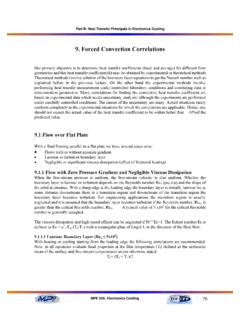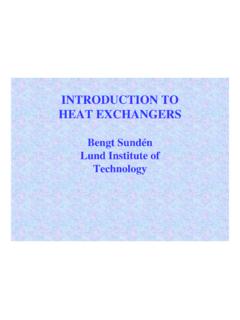Transcription of Thermal Properties of Foods - Encyclopedia of Life Support ...
1 food ENGINEERING Vol. I - Thermal Properties of Foods - Lozano, Jorge E. Thermal Properties OF Foods . Lozano, Jorge E. Plapiqui (UNS-CONICET), Camino La Carrindanga, Km. 7 (8000) Bah a Blanca, Argentina Keywords: Boiling point rise, density, freezing depression, heat capacity, porosity, Thermal conductivity, Thermal diffusivity, thermophysical Properties , viscosity. Contents 1. Introduction food Properties during Freezing TE SS. Water Content S. 2. Experimental Data and Prediction Models 3. Density R. AP L. Definition and Units Porosity H O. Density Measurement Bulk Density of Selected Foods C E. Theoretical Density Models 4. Specific heat E O . Definition and Units Measurement Methods Specific heat of Selected Foods Prediction Models PL C. Empirical Equations 5.
2 Thermal Conductivity M ES. Definition Measurement Methods Selected Values SA N. Prediction Models Empirical Equations U. 6. Thermal Diffusivity Definition Measurement Techniques Thermal Diffusivity of Selected Foods Empirical Equations 7. Boiling Point Rise and Freezing Depression Definitions Measurement Methods 8. Viscosity Definition 9. Conclusions Glossary Bibliography Biographical Sketch Encyclopedia of Life Support Systems (EOLSS). food ENGINEERING Vol. I - Thermal Properties of Foods - Lozano, Jorge E. Summary Thermophysical Properties , a well-known group of Thermal and related Properties , are necessary for the design and prediction of heat transfer operation during handling, processing, canning, and distribution of Foods . In this article, the most important Properties associated with the transfer of heat in Foods are defined.
3 Measurement techniques, available empirical equations, and mathematical models used for prediction of density, porosity, specific heat , Thermal conductivity, and Thermal diffusivity are presented and condensed in tables, figures, and graphs. This article also provides data and information for increasing the boiling point of liquid Foods over that of water and decreasing the freezing point below that of water, the phenomena known as boiling point rise and freezing depression, respectively. 1. Introduction TE SS. S. Most processed Foods and many freshly consumed foodstuffs receive some type of heating R. or cooling during handling or manufacturing. Design and operation of processes involving AP L. heat transfer requires special attention, due to the heat -sensitivity of Foods .
4 Both theoretical H O. and empirical relationships used when designing or operating heat processes require knowledge of the Thermal Properties of the Foods under consideration. food Thermal C E. Properties can be defined as those Properties controlling the transfer of heat in a specified food . They are usually grouped as thermodynamical Properties ( , specific E O . volume, specific heat , enthalpy, and entropy) and heat transport Properties ( Thermal conductivity and Thermal diffusivity). However, when considering the heating or cooling of Foods , it is well known that other physical Properties must be considered because of their intrinsic relationship with the mentioned pure Thermal Properties . PL C. Such is the case of density, porosity, and viscosity (see food Rheology and Texture, and Engineering Properties of Foods ).
5 M ES. Therefore, a well-known group of Thermal and related Properties , thermophysical Properties , provides a powerful tool for the design and prediction of heat transfer SA N. operation during handling, processing, canning, and distribution of Foods . In spite of the profuse generation and compilation of thermophysical Properties of food , they are not U. always available to the design engineer. Finding relevant data is usually the controlling step in the design of a given operation, and as Foods are such a broad set of materials, the best solution is frequently the experimental determination. This article provides data and information for calculating the Thermal processes of foodstuffs, including a brief description of the most widely used methods for the measurement and determination of thermophysical Properties .
6 Thermophysical Properties of Foods include, in a broad sense, different types of parameters associated with the heat transfer operations of food processing. heat transfer involves the transfer of heat into or out of a food . There are three ways that heat can be transferred: by radiation, conduction, or convection. Radiation is the transfer of heat by electromagnetic waves ( , in a microwave oven). Conduction is the movement of heat by direct transfer of molecular energy within solids ( , heating of a food by direct fire through metal containers). Convection is the transfer of heat by groups of molecules that move because of a gradient of density or agitation ( , the stirring of liquid Foods ). Encyclopedia of Life Support Systems (EOLSS). food ENGINEERING Vol.
7 I - Thermal Properties of Foods - Lozano, Jorge E. Mechanism Condition Governing equation *. Radiation Infrared heating Q= A T4. Microwave heating X= o/{2 ( tan )1/2}. Conduction (unidirectional) Steady state Q = A( 1- 2)/x Unsteady state d /dt= d2 /dx2. Convection Q= hs A ( 1- 2). natural Gr= 2g l3 T/ 2. Nu= K (Gr Pr)a Nu= f(Re, Pr)= hl/ k forced Pr= c / . Re= lv / . hc= convective heat transfer coefficient; l= characteristic dimension; = Thermal diffusivity; = coefficient of Thermal expansion; = Thermal conductivity; =. TE SS. Density; = Porosity; = dielectric constant; c= Specific heat ; = Viscosity; Gr=. S. Grashoff; Re= Reynolds; Pr= Prandtl; Nu= Nussell. R. AP L. H O Table 1. Simplified description of heat transfer mechanisms. heat transfer can take place in 1) a steady-state manner, by keeping the temperature C E.
8 Difference constant between two materials; or 2) in an unsteady-state manner, when temperature is constantly changing. Calculation of heat transfer under these conditions is E O . extremely complicated, but can be simplified by making a number of assumptions and, in some cases, using prepared graphic or tabulated information to give approximate solutions. Table 1 shows the basic equations used to calculate the rate of heat transfers under different mechanisms and conditions. PL C. This information is needed for a variety of research and engineering applications, including M ES. design and optimization of handling and processing units such as tanks, pumps, pipes, chillers, evaporators, and heat exchangers. Moreover, information on thermophysical Properties is required over a wide range of concentrations and temperatures.
9 The vapor SA N. pressure of most aqueous solutions is lower than that of water at the same temperature. Therefore, for a given pressure, the boiling temperature (boiling point) of the solution is U. higher than that of pure water. The increase in boiling point, or boiling point rise (Tr) of liquid Foods , is a property of interest in the design and operation of evaporators. The temperature at which Foods freeze, usually known as the freezing point (Tf), is generally not easily defined, due to the complex changes occurring during phase transition in Foods . While the relation between the freezing point and vapor pressure for pure water and simple aqueous solutions has been precisely defined, in the case of food systems where various solutes eventually reach their eutectic temperature (solute crystallization), prediction of depression of freezing point (Tf) requires a more complex treatment.
10 During processing, the temperature within a food changes continuously, depending on the temperature of the heating medium and two Properties of the food : Thermal conductivity ( ) and specific heat (cp). On the other hand, Thermal diffusivity ( ) is related to and cp through density: Encyclopedia of Life Support Systems (EOLSS). food ENGINEERING Vol. I - Thermal Properties of Foods - Lozano, Jorge E. = / cp (1). When a piece of food is heated or cooled by a fluid, both the surface heat transfer coefficient and are the resistance to heat transfer , related as follows: Bi = h / (2). where h (W m-2 K-1) is the heat transfer coefficient, the characteristic half dimension, and (W m-1 K-1) is the Thermal conductivity. At small Bi (< ), the surface film is the predominant resistance, while for Bi> , the Thermal conductivity limits the rate of heat transfer .














